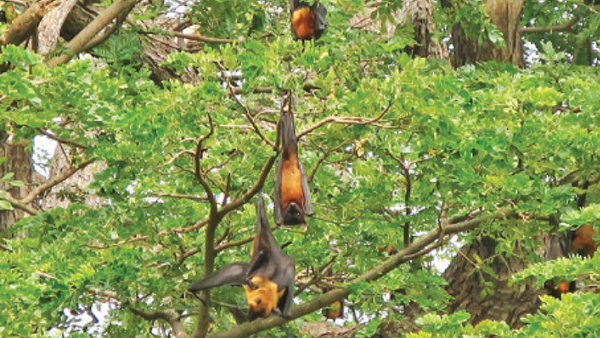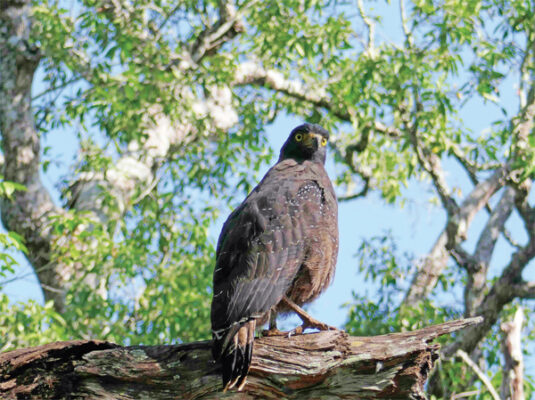Sri Lanka is full of magical spots where you can go beyond looking for the big five and enjoy the rich variety of bird life on a boat trip motoring through ornamental flowers and lotus picked as temple donations in the 1.2 kilometres by Great King Maha Naga. A king who ruled Tissa with imagination and love of inspiring advanced irrigation practices for the countries rich agriculture and wildlife. This exciting bird and wildlife area that allows you to get close to the fresh water crocodiles can only be done by boat as the government do not want you to be the crocodiles dinner as they can grow up to 13 feet in this area. You can go early morning to see the water birds or late afternoon to enjoy the nesting, mating and cross over of birds returning to their home ranges at the end of the day as the fruit bats leave hanging out in the trees to find their nocturnal food supplies. You can also enjoy a spectacular sun set over the temples, lake, ancient trees, pagodas and villagers returning on their singer bikes piled high with wood to cook on at the end of a busy day.
 |
| Explore the natural world from the safety of a boat |
Safety is paramount so a life jacket is put on at the start of the trip and lots of sun tan lotion as the water reflection can cause sunburn. The trip over two hours circum navigates the tank in a clockwise pathway that in the season you will see more than 15 varities of birds including Imperial Pigeon, Pompodor Pegio, Common Myna, White Brested Kingfisher, Spotted Dow, Asian Koal, Kingfisher, Malabar Horn Bill, Rose Ring Parakit, and Brown Headed Barbet. Here among the lotus flowers you will find men and women in a vehicle tube rowing as they pick the lotus to sell as bunches for pilgrims going around the temples and in particular Kataragama. This is also a great spot for fishing as the tank has at least five types of fish which you will see on a clear day in the water or in the nets of the fisherman as the tour includes watching this ancient practice. Fish types include Black Spotted Fillamented Barb, Olive Barb, Gar Fish, Catla Fish, Tilapia Fish, and Snake head.
To enjoy the nesting and eating activities of the birds we stop under a Para Mara tree and have tea with short eats in the morning and at teatime also delicious home made butter cake. This is a good time to get out the binoculars and really study the bird’s activities in detail and then head off past the major historical stupas Tissa Maharamya and Yatala Tissa temples, which are fabulous for water refection photos. Ending with Bird Island learning about the nesting periods of the bird’s species, which the local naturalists will tell you all about as the sun sets.
 |
| The lotus collectors are as much part of the natural landscape as they collect flowers daily for the pilgrims to take to kataragama |
 |
For something a bit different you can head to the remote jungle areas of the island around Wellawaya, where it possible to see the illusive flying squirrel or a bull elephant trying to steal fruit at dead of night and noisy peacocks strut around. However it is the flying squirrels that capture my sons imaginations as they look like a squadron of planes as they glide through the coconut trees at night ooking for edible fruit flowers and insects to eat. The illusive flying squirrels quest is ultimately to devour the delectable mango flowers, and not as many have suggested the mango fruit, which they enjoy during the green mango season. A time you may just get lucky and see one of these magical creatures up close and personal, giving you a chance to understand a little more about these cartoon like characters, which are at their most active just after the sun set.
You can’t like bats or geckos listen out for flying squirrels as they are silent except when flying from tree to tree making rustling noises as they land from branch to branch making them difficult to track and research these fascinating forest dwellers and like the tall trees in particular, where they find a hollow and spend the daytime hidden away in it sleeping in these natural abodes filled with leaves for warmth only emerging at nighttime to take to the skies in their stealth like missions. Although if you miss the silent illusive flyers, you can at least spot the giant squirrels early morning, as they are also great lovers of mangos, and lots of fun to watch in season.
If you want to see these flying magicians why not like the squirrels sleep during the day and spend the night jwatching out for an animal that is approximately two feet long with its bushy tail and about half the size without it. Amzar and Samad my two sons love nature walks at night as they get to use a special red light torch, which allows them to spot loads of animals without disturbing their habitat or nightly rituals. They learn that that flying squirrel groups are found in the central regions of the island and are more common in Kandy, Matale and Teldeniya areas. We learn the appellation ‘flying’ is a misnomer because these squirrels cannot actually fly as they have fairly thick membranes, extending between the front and back legs on both sides, which reach down to the toes of both fore and hind feet. So the way they travel is more like the way one would use as a parachute to glide down from tall trees to the lower branches of another tree in the forest before clawing their way back up to the top. To suddenly encounter a silent flying object, just above your head, in the forest at night is quite disconcerting. Since there is no flapping of wings, the glide is silent unless branches are touched and these nocturnal flyers do not even squeak like the bats or other nocturnal creatures like the gribbeting noisy frogs or sex maniac peacocks who never stop calling in the mating season as they round up all the hens in the area.
Flying squirrels subsist mainly on the mango flowers and not the fruit, which they hold in their front paws with their incredibly sharp pincer like claws nibbling away at each flower in the most delicate of fashion. They also love consuming jungle twigs bark, small leaves, insects and larvae. They are like the birds and the bats an integral part of our biodiversity, as they disperse the seeds of the trees throughout the forest so that these species of trees will continue to grow in numbers.
For more interesting wildlife head to Yala’s perimeter fence and discover the fascinating world of Vampire bats with Jetwing Yala naturalist, who will tell you many
 |
| Nocturnal nighlife just as fascinating whether it be a lizard or snake |
fascinating things including that this is the only mammals that feed off animal blood but this is just one species of over 1,100 species of bats worldwide, representing 20% of all mammal species, of which 30 can be found in Sri Lanka. If you are not scared of their bloodlust, you might be scared of the very largest of them, the giant golden-crowned flying fox, which can have a wingspan greater than the average adult woman’s height. Then you might be unnerved by their being the only mammals capable of sustained flight and then by the fact that they are more adept than birds at changing direction, flying fast and protecting the planet from unwanted insects. Bats are also responsible for a great deal of pollination by the highly specialised microbats, dispersion of seeds by the fruit-eating megabats, and the provision of a very rich fertiliser, in the form of their excrement, harvested from caves.
Bats whether hanging off trees or in flight over head are amazing to observe. The tragedy is they are becoming increasingly endangered and tragically some species have been wiped out altogether owing mainly to unhealthy farming pesticides that accumulate in their prey. Seeing these and other nocturnal animals is as fascinating as going on a national parks safari or bird watching trip. In fact just walk outside where you are living and discover just how many amazing creatures live in and around your home garden and even in the heart of the big city centres.

| Natures wonder – giant squirrels |

Binoculars and being on a boat allows you to see birds up close and personal without going close to them






